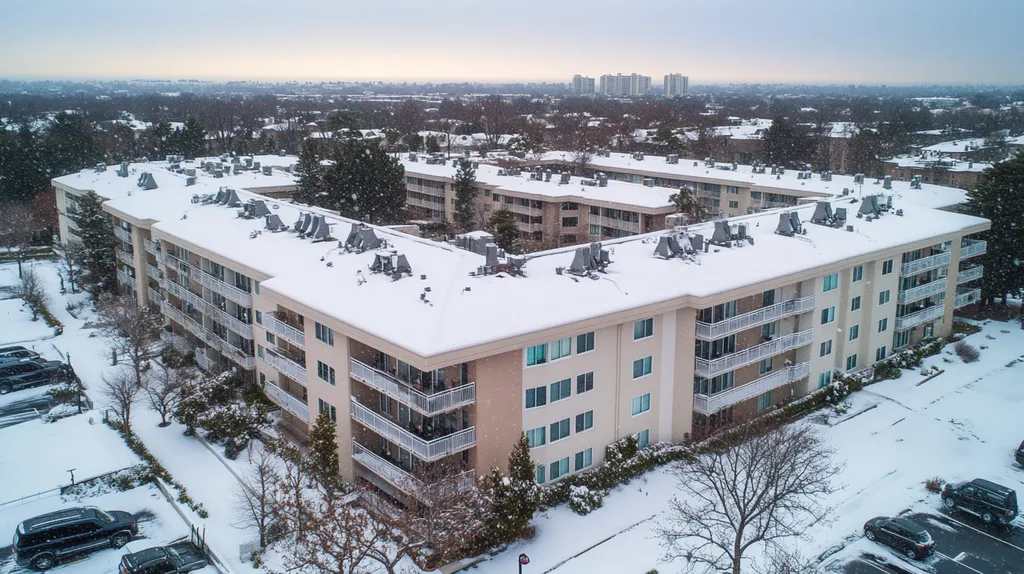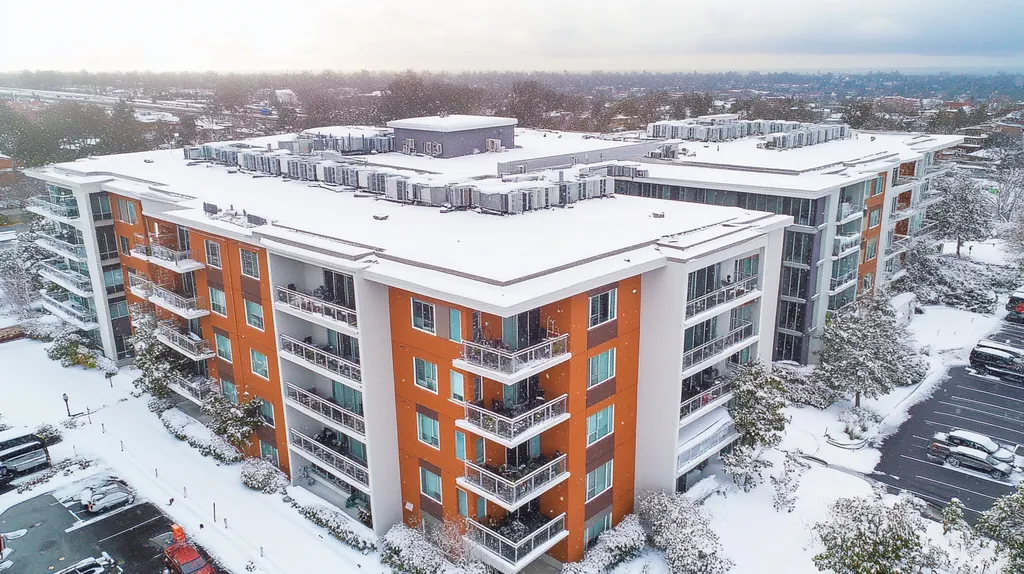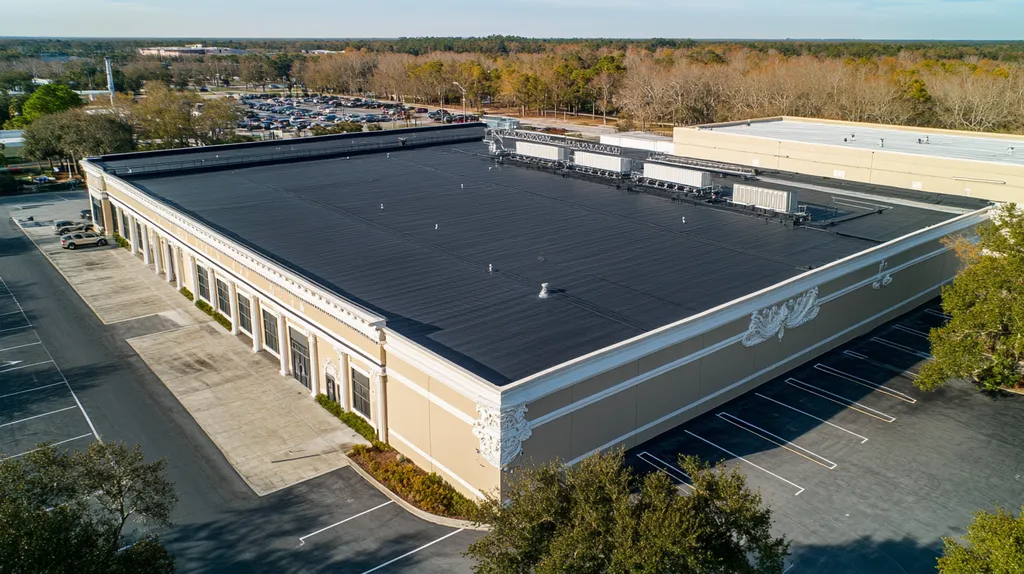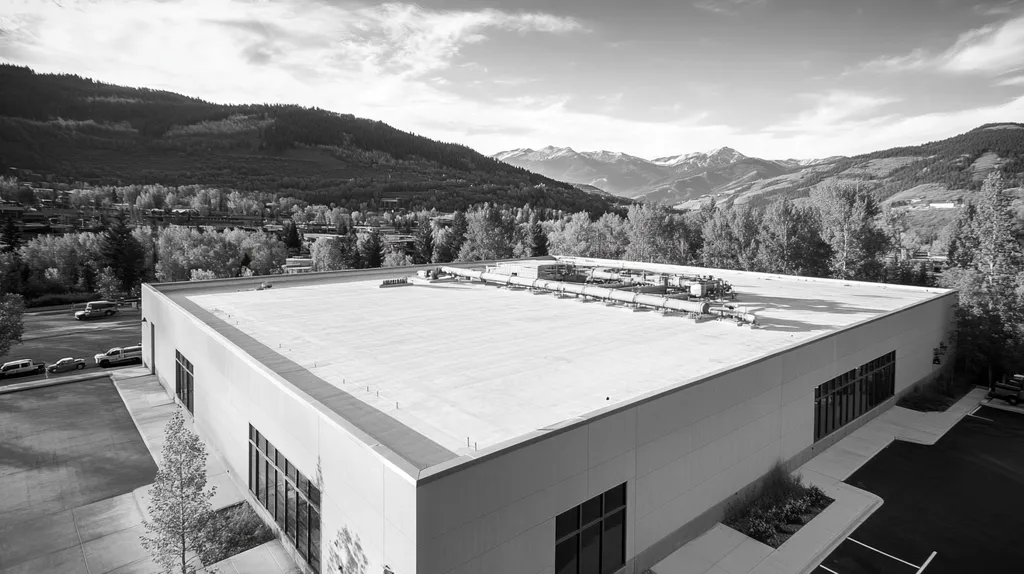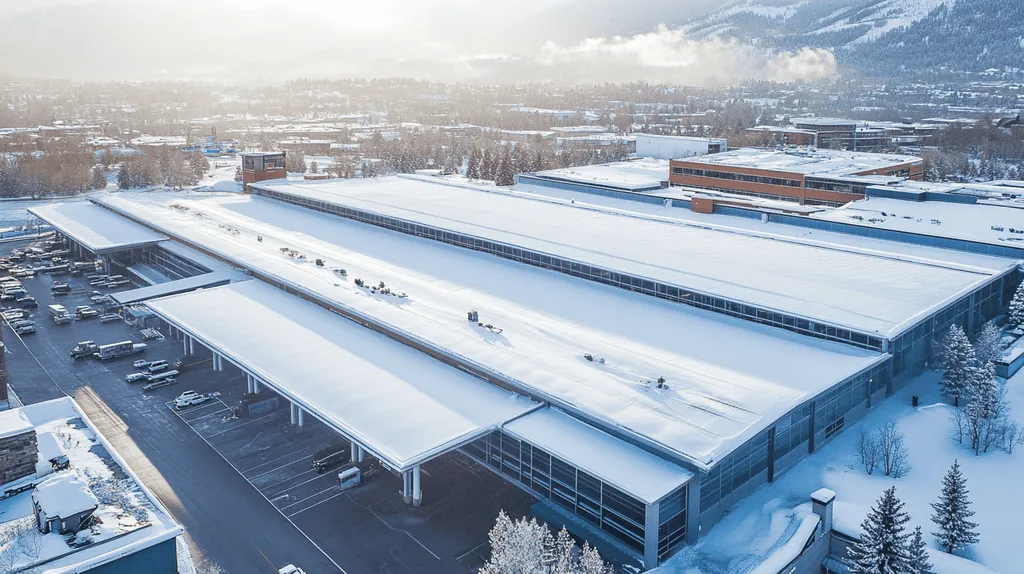Every year, over 300 workers lose their lives due to falls from heights, with commercial roof accidents ranking among the deadliest workplace incidents according to OSHA statistics.
For facility managers, ensuring safe roof access isn’t just about compliance—it’s about preventing tragedy and protecting both workers and assets.
This comprehensive guide explores the critical factors for establishing secure roof access, from performance requirements and financial considerations to compliance standards and risk management protocols.
By following these actionable solutions, property managers can create safer environments while reducing liability and operational disruptions.
SECTION 1: PERFORMANCE FACTORS
Ensuring safe access to commercial roofs isn’t just a good idea—it’s essential for preserving building integrity and safeguarding workers. Falls are consistently among the leading causes of workplace fatalities, particularly in the roofing sector, which is notorious for its risks. Facility managers dedicated to safety must proactively identify hazards before anyone steps foot on a roof. This section focuses on three key performance factors critical to establishing secure roof access: assessing roof access points, evaluating elevation changes and obstacles, and ensuring stable, secure surfaces.
Assessing Roof Access Points
The first critical task in ensuring safe roof access is to conduct a careful assessment of all access points. Roof ladders, stairways, and hatches should be inspected regularly for compliance with safety standards. Design flaws can lead to hazardous conditions, especially if access points are in areas where water tends to pool or accumulate debris.
Facility managers should ensure these access points are not only clearly marked but also meticulously maintained. Regular inspections can spot wear and tear that may compromise safety. Additionally, adequate lighting should illuminate access areas to prevent accidents during low-visibility conditions.
It is also essential to display signage indicating weight limits and safety protocols prominently. This transparency not only informs workers but also minimizes the risk of liability claims stemming from unsafe access conditions. By actively managing access points, facility managers can greatly reduce the risk factors associated with roof access.
Key Action Items
Evaluating Elevation Changes and Obstacles
Elevation changes can pose significant challenges during roof access. Slopes, ledges, and uneven surfaces can create precarious fall hazards that require thorough evaluation. Facility managers must assess these elevation changes to determine if additional safety measures, like guardrails or harness systems, are necessary.
Furthermore, obstacles such as HVAC units, vents, or parapets can complicate safe access. Continuous assessments help identify these barriers and ensure that pathways remain clear and unobstructed. Addressing elevation-driven hazards requires innovative solutions tailored to each roof’s unique layout.
Signage indicating changes in elevation can help keep workers vigilant while navigating the roof. This straightforward measure can play a crucial role in preventing slips or falls during routine inspections or maintenance tasks.
Key Action Items
Ensuring Stable and Secure Surfaces
The condition of roof surfaces significantly impacts safe access. Weather conditions or surface wear can create slip hazards that jeopardize safety. Facility managers should regularly inspect roof surfaces to assess their stability and security for worker navigation.
Routine maintenance is crucial to ensure that surfaces do not become slippery from algae, moss, or ice buildup. Promptly addressing any surface damage is essential to maintain a safe working environment. Moreover, opting for slip-resistant materials can elevate safety levels on rooftops.
Facility managers should also establish seasonal evaluations to anticipate weather-related hazards that could affect roof conditions, particularly after snow or rain. Keeping workers informed about the current state of the roof before access occurs is likewise crucial for safety.
Key Action Items
SECTION 2: FINANCIAL CONSIDERATIONS
Facility managers are often faced with tough financial hurdles when it comes to ensuring safe access to commercial roofs. Compliance with safety standards isn’t just about avoiding fines; it’s about protecting both employees and valuable investments. Failing to implement the right safety measures can lead to disastrous accidents, damaged equipment, and hefty legal liabilities. This section dives into budgeting for essential safety measures, understanding compliance costs, and reaping the long-term financial benefits of these investments.
Budgeting for Safety Equipment and Installations
Starting with the budget for safety equipment is critical for facility managers. Items like guardrails, harnesses, and access ladders must be included not just in initial budgeting but also in ongoing financial planning. The intricacies of installation costs can differ based on roof type and specific safety requirements, making it crucial to factor these into budget discussions.
For example, safety setups for flat roofs may differ significantly from those for sloped rooftops. Working closely with roofing experts helps clarify safety needs and associated costs. Regularly revisiting the safety budget ensures it stays aligned with evolving regulations and roof conditions.
While investing in top-quality safety equipment might seem pricey at first, this usually results in superior durability and reliability. Cheaper options may look attractive initially but can lead to hidden costs or safety risks down the line. Ultimately, a well-crafted safety budget acts as a protective shield for both employees and the facility’s overall financial health.
Key Action Items
Calculating Costs of Compliance and Training
Compliance with safety regulations necessitates a commitment to staff training programs, which can represent significant costs. Facility managers should scrutinize these expenses closely as compliance training reduces accident risks that could incur hefty financial repercussions later on.
For instance, training staff on proper roof access techniques can significantly minimize fall incidents, one of the most common workplace injuries. The financial fallout from accidents can include not just medical costs but also legal expenses from litigation.
Additionally, maintaining compliance can involve regular audits and inspections, which may come with costs but are essential for catching potential issues before they escalate. Investing in compliance is not simply a matter of operational cost; it can be viewed as a proactive financial strategy that protects both employees and the bottom line.
Key Action Items
Estimating Long-Term Savings from Safety Measures
Even though initial expenditures for safety measures can seem substantial, the long-term savings can be remarkable. Facility managers should recognize that investing in safety translates into a lower risk of incidents, which can lead to reduced insurance premiums over time. Many insurance providers offer discounts for documented safety practices and successful training programs.
Fewer accidents mean fewer worker compensation claims, significantly impacting the facility’s financial outlook. Each incident averted is not just a victory for safety; it translates into real financial benefits. When assessing future budgets, facility managers should calculate potential savings from reduced downtime, lower absenteeism, and minimized property damages.
Moreover, enhanced safety can elevate employee morale and productivity. Workers who feel safe are more likely to perform effectively and are less inclined to leave, leading to reduced turnover and the costs of new hires. These secondary savings further emphasize the value of investing in roof safety measures.
Key Action Items
SECTION 3: COMPLIANCE REQUIREMENTS
Safe access to commercial roofs hinges on strict compliance with essential regulations. The Occupational Safety and Health Administration (OSHA) highlights falls as the leading cause of fatalities in the construction realm, with a staggering 300 deaths reported each year. Facility managers must skillfully navigate a maze of federal, state, and local safety regulations to minimize these risks. Understanding compliance is not just about avoiding penalties; it’s about ensuring the safety and well-being of all personnel.
OSHA Regulations for Roof Access and Fall Protection
OSHA outlines crucial regulations for roof access and fall protection that facility managers must follow. For example, when workers are on roofs six feet or higher, implementing proper fall protection measures like guardrails or safety harnesses is mandatory. The use of approved ladders and scaffolding is essential for secure access.
Regular training on fall hazards and safe roof access procedures is also required to keep safety at the forefront. Compliance with OSHA standards not only bolsters worker safety but also reduces the risk of costly citations that can arise from non-compliance.
Routine assessments of roofing practices against OSHA guidelines are crucial. Conducting safety audits can unveil compliance gaps and offer immediate opportunities for improvement. Embracing these safety measures not only safeguards workers but cultivates a culture of safety that permeates the entire organization.
Key Action Items
Local and State Safety Standards for Commercial Roofs
Beyond federal guidelines, local and state safety standards present additional requirements for commercial roofs that vary widely by location. These regulations may specify aspects such as roof construction, designated access points, and visibility requirements. For instance, some areas necessitate personal fall arrest systems regardless of the roof’s height.
Non-compliance with these local rules can elevate liability in the event of accidents, so it’s vital for facility managers to stay updated on changes that could impact roofing operations.
Partnering with local safety consultants or legal advisors can provide valuable insights to ensure comprehensive compliance. This proactive stance not only mitigates risks but also safeguards both the facility and its workforce while enhancing safety protocols, which may lead to lower insurance premiums.
Key Action Items
Documentation and Record-Keeping for Compliance
Keeping thorough documentation and records is essential for proving compliance with safety regulations. Facility managers should maintain detailed logs of safety training, incident reports, and equipment inspections. Proper documentation not only confirms compliance but also helps evaluate the effectiveness of safety measures.
Utilizing digital tools can streamline record-keeping, making it easier to monitor compliance across various facilities. Regular reviews of these records help spot patterns that may need attention and prevent future issues.
Moreover, maintaining precise records can significantly strengthen defenses against legal claims stemming from workplace accidents. In the case of inspections or audits, comprehensive documentation can safeguard against costly fines and enhance the facility’s credibility.
Key Action Items
SECTION 4: RISK MANAGEMENT
Prioritizing safety on commercial roofs is non-negotiable for facility managers. With falls ranking as the leading cause of fatalities in construction, as noted by the Occupational Safety and Health Administration (OSHA), identifying potential hazards and implementing effective safety measures can dramatically decrease accident risks. This section explores key elements of risk management, highlighting fall hazards, the implementation of safety systems, and addressing weather-related risks.
Identifying Potential Fall Hazards and Trip Risks
Before accessing any commercial roof, it’s essential to assess potential fall hazards. Common culprits include unprotected edges, skylights, and rooftop equipment, each posing unique dangers. Comprehensive roof inspections should be a staple in maintenance protocols, ensuring that all threats are systematically identified.
Moreover, the roof layout itself often contributes to trip risks. Items like tools, materials, and debris can turn safe paths into potential hazards. By establishing designated storage areas for tools and equipment, facility managers can dramatically reduce these risks, while clear hazard labeling adds an extra layer of safety for all workers.
Incorporating hazard identification into the planning stages of roof access amplifies overall safety. Comprehensive training for personnel involved in roof access fosters a culture of safety awareness, minimizing incidents and aligning with industry best practices. Regular updates to hazard assessments are vital, particularly with each new roofing project or maintenance activity. Ignoring this can leave workers vulnerable to unforeseen dangers.
Key Action Items
Implementing Personal Fall Arrest Systems
Personal Fall Arrest Systems (PFAS) are fundamental for safeguarding workers on commercial roofs. These systems encompass harnesses, lanyards, and anchor points designed to catch workers during a fall, minimizing the risk of serious injury. Selecting appropriate PFAS equipment tailored to the specific roof conditions is crucial.
Factors such as roof slope, obstructions, and height all influence system effectiveness. Proper training on the correct use and maintenance of PFAS is equally essential. Regular inspections ensure reliability, as worn or damaged components need immediate replacement to prevent failures during operation.
Additionally, establishing a detailed rescue plan is critical for effectively responding to fall incidents. By implementing PFAS and ensuring thorough training, facility managers not only comply with regulations but also cultivate an environment where safety is prioritized, ultimately reducing liabilities.
Key Action Items
Mitigating Weather-Related Safety Risks
Weather can introduce substantial risks for workers accessing commercial roofs. High winds, rain, and extreme temperatures create hazardous conditions that can lead to accidents. Therefore, facility managers must stay vigilant and adjust roofing activities in response to changing weather conditions.
Creating a weather-related access policy can delineate when it’s unsafe to work on roofs, such as during gusty winds or when surfaces are slippery due to rain or ice. Providing real-time weather updates to staff enhances safety efforts and helps workers make informed decisions.
Seasonal changes also impact roof access, as accumulated snow can necessitate specific removal strategies. Training workers on how to handle weather-related challenges is vital for maintaining safety during such conditions. By incorporating weather risk assessments into the overall safety plan, facility managers can minimize weather-related accidents and foster a safer working environment.
Key Action Items
SECTION 5: OPERATIONAL PROCEDURES
Safe roof access isn’t just about following regulations; it’s a cornerstone of workplace safety and efficiency. With falls from roofs being a significant contributor to workplace injuries, facility managers need to implement detailed operational procedures to address these hazards. In this section, three pivotal areas will be explored: crafting safe access routes, comprehensive training for roof access safety, and establishing effective emergency response plans.
Safe Access Routes and Walkway Design
Creating clear and safe access routes is vital for minimizing accidents on commercial roofs. Establishing designated walkways helps guide workers and service personnel, keeping them away from potential hazards. It’s essential that these paths remain free of debris and other obstructions.
Walkways need to be made from non-slip materials and clearly marked for better visibility. Incorporating guardrails and safety barriers can further enhance safety by minimizing the risk of falls during roof access.
Frequent inspections of these routes help identify wear and potential hazards. This proactive maintenance leads to safer conditions and ultimately fosters a culture of safety across the facility.
Key Action Items
Training and Education for Roof Access Safety
Training is the backbone of safe roof operations. It is imperative that every employee accessing the roof receives thorough safety training tailored to the unique hazards they may encounter. This training should encompass recognizing roof hazards and understanding the correct use of personal protective equipment (PPE).
Regular refresher courses are essential to keep safety procedures fresh in everyone’s mind. Consistent education helps staff stay updated on new safety protocols and evolving technologies.
Practical demonstrations enhance this training, ensuring employees are proficient in safely using ladders, harnesses, and other crucial equipment. Documenting all training sessions creates an invaluable record for audits and inspections.
Key Action Items
Emergency Response and Rescue Plans
Having a well-structured emergency response plan is essential for facilities that involve roof access. Each facility manager should create a customized emergency response strategy informed by the building’s unique layout and associated risks.
This plan should include procedures for various emergencies such as falls, severe weather events, and equipment failures. Assigning clear roles to trained personnel helps facilitate an effective coordinated response during emergencies.
Regular drills are crucial to ensure that all staff are familiar with the emergency procedures. These drills not only highlight potential gaps in the plan but also build a culture of preparedness that strengthens overall safety. Keeping communication lines open with local emergency services accelerates crisis response, enhancing safety on commercial roofs.
Key Action Items
SECTION 5: OPERATIONAL PROCEDURES
Ensuring safe access to commercial roofs is not merely a regulatory requirement; it is fundamental for workplace safety and operational efficiency. With falls from roofs contributing significantly to workplace injuries, facility managers must prioritize thorough operational procedures to address these hazards. This section will focus on three key areas: designing safe access routes and walkways, providing comprehensive training for roof access safety, and developing effective emergency response plans.
Safe Access Routes and Walkway Design
Creating clear and safe access routes is vital for minimizing accidents on commercial roofs. Designated walkways should be established to guide workers and service personnel, ensuring they steer clear of potential hazards. These paths must be kept free of debris and obstacles.
Walkways need to be constructed with non-slip materials and prominently marked for better visibility. Incorporating guardrails and safety barriers where necessary further enhances safety by reducing fall risks during roof access.
Regular inspections of these routes are essential to identify wear or potential hazards. This proactive maintenance approach leads to safer conditions for users and cultivates a culture of safety throughout the facility.
Key Action Items
Training and Education for Roof Access Safety
Training is the backbone of safe roof operations. Every employee who accesses the roof should receive thorough safety training tailored to the hazards they may encounter. This training should encompass recognizing roof hazards and correctly using personal protective equipment (PPE).
Regular refresher courses are essential for keeping safety top of mind. Continuous education ensures employees stay informed about the latest safety protocols and technologies.
Incorporating practical demonstrations into training helps employees practice safely using ladders, harnesses, and other critical equipment. Documenting all training sessions creates a vital record for audits and inspections, solidifying the facility’s commitment to safety.
Key Action Items
Emergency Response and Rescue Plans
A solid emergency response plan is essential for facilities that involve roof access. Every facility manager should develop a customized emergency response strategy based on the unique layout and risks of their building.
This plan must outline procedures for various emergencies, including falls, severe weather, and equipment failures. Clearly defined roles for trained personnel will facilitate an effective coordinated response when an emergency arises.
Regular drills are critical for familiarizing staff with emergency procedures. These rehearsals highlight potential gaps in the plan and foster a culture of preparedness. Maintaining communication with local emergency services further enhances crisis response, ensuring safety on commercial roofs is top-notch.
Key Action Items
The Bottom Line
With over 300 workplace fatalities from falls each year, the stakes for proper roof access couldn’t be higher. Industry data shows that facilities implementing comprehensive safety protocols reduce accident rates by up to 85%.
Success hinges on three critical factors: rigorous adherence to safety standards, consistent training programs, and regular equipment maintenance.
The financial impact of neglecting roof safety can be devastating, with the average workplace fall incident costing organizations $150,000 in direct expenses alone.
By following the actionable solutions outlined in this guide, facility managers can create safer environments, reduce liability exposure, and protect their most valuable asset – their workforce.
The time to enhance your roof safety program isn’t tomorrow – it’s today.
FREQUENTLY ASKED QUESTIONS
Q. How do I assess roof access points for my commercial roof?
A. Assessing roof access points involves regularly inspecting ladders, stairways, and hatches for safety compliance. Ensure each access point is clearly marked and well-maintained, with adequate lighting to prevent accidents. Check for water pooling or debris accumulation that could create hazards.
Q. What should I include in my budget for an industrial roof safety plan?
A. Budgeting for an industrial roof safety plan should include costs for safety equipment, installation fees, and ongoing maintenance. Monitor training expenses and potential compliance costs to ensure your budget covers both current needs and unexpected issues that may arise.
Q. What are the key OSHA regulations for accessing commercial roofs?
A. OSHA regulations for accessing commercial roofs emphasize the need for fall protection when working at heights. Ensure that guardrails or safety harnesses are in place and workers are trained on fall hazards and proper use of equipment to maintain compliance and prevent accidents.
Q. How do I manage weather-related risks for my industrial roof?
A. To manage weather-related risks, implement a weather-related access policy detailing unsafe conditions, such as high winds or wet surfaces. Provide real-time weather updates and develop guidelines for adverse weather work to protect staff from hazards like slippery surfaces or extreme temperatures.
Q. What operational procedures should I implement for roof safety?
A. Key operational procedures include designing clear access routes, providing thorough safety training, and developing emergency response plans tailored to your facility’s needs. Regular inspections and the incorporation of safety measures into your operational protocols will enhance overall safety for roof activities.
Q. How can I ensure my team is trained for commercial roof access safety?
A. Ensure your team undergoes comprehensive training on safety protocols specific to roof access. Incorporate practical demonstrations and regular refresher courses to keep skills sharp. Document training sessions and feedback to continuously improve the education process and address safety effectively.
Q. What additional safety measures are critical for industrial roofs?
A. Besides fall protection and proper training, consider implementing Personal Fall Arrest Systems, clear hazard labeling, and designated tool storage areas. Regular safety audits and real-time monitoring of roof conditions enhance your facility’s overall safety and compliance standards significantly.

